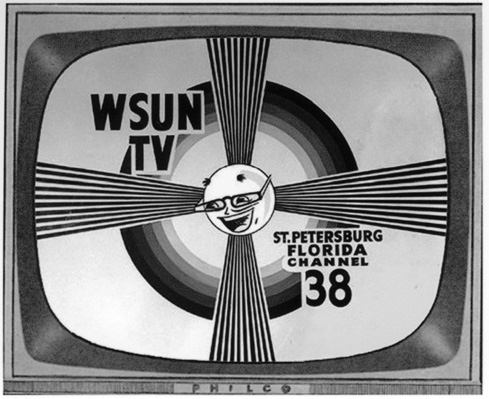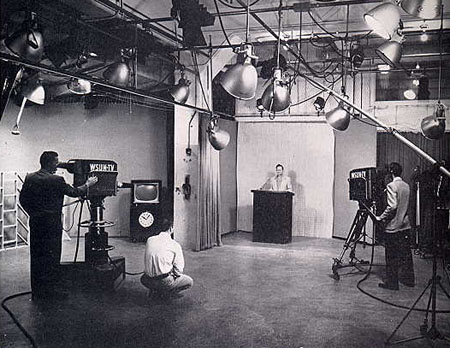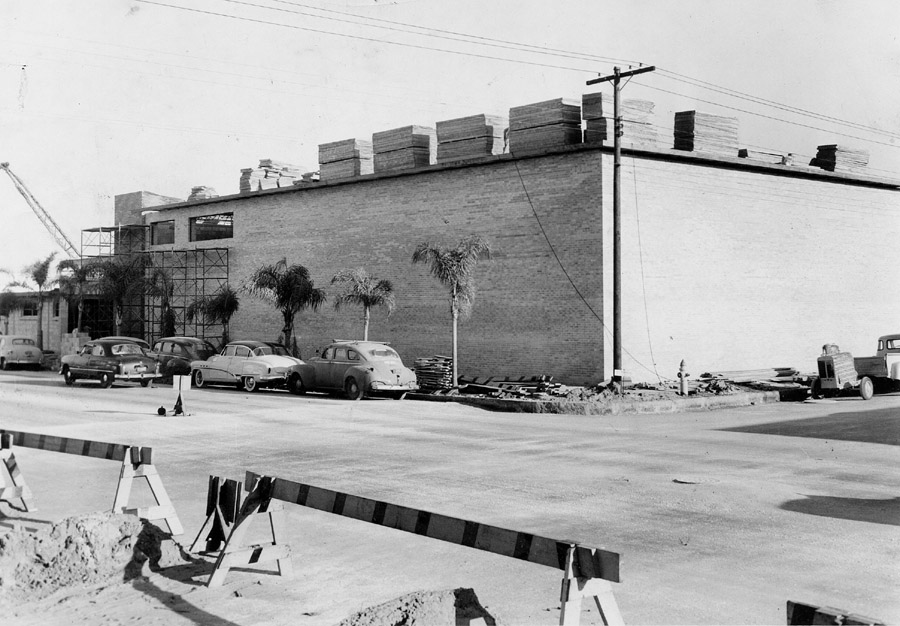
'Mr. Sun' was the mascot for the City of St. Petersburg and
WSUN-TV (logo courtesy Bob Shields)
Pre-Air History of WTVT
Continued
...LIVE, FROM THE MILLION DOLLAR PIER...

'Mr. Sun' was the mascot for the City of St. Petersburg and
WSUN-TV (logo courtesy Bob Shields)
In early 1952 the F.C.C. allocated channels 8, 13, and 38 for the Tampa Bay area. A half-dozen potential television broadcasters began filing applications for the three available licenses.
Channel 38 was to be among the nation's first television stations on a UHF frequency. It was a time when UHF was broadcasting's stepchild since few existing TVs were capable of UHF reception and new sets would require a UHF tuner at extra expense. Although the F.C.C. promoted UHF and promised its support, almost ten years passed before government rulings made it mandatory for UHF tuners to be included on all TV sets sold in the United States. This situation would make it harder for the owner of channel 38 to compete with VHF outlets that would soon follow in the Tampa Bay area. There must have been some realization of that fact among parties interested in getting into television because only two applicants lined up to apply for the channel 38 license...The Empire Coil Company of New Rochelle, NY, and locally owned WSUN radio.
WSUN radio was unique in that it was owned and operated by the City of St. Petersburg. The city's success with WSUN radio was listed on their F.C.C. license application as a significant reason for receiving a television license. City managers at the time felt that television would be a good addition to the radio station and that there would be less expense in the form of litigation for the license due to the belief that its UHF frequency was less attractive to potential bidders. This theory would soon be proven correct when Empire Coil abruptly withdrew their application for Channel 38 and St. Petersburg was awarded the license by default.
The City of St. Petersburg has a long history of questionable decisions regarding the use of resources and this tradition continued with the planning of Channel 38. It was decided that WSUN-TV's studio was to be located on the ground floor of the famous 'Million Dollar Pier' on St. Pete's bayfront (WSUN radio had been a long-time tenant at the pier). Putting a television operation onto the pier with its limited space and remote location did not make it easy for engineers and programmers to provide a busy schedule of local programming. In fact, Channel 38's one small studio was a former trolley turnaround. However, the challenge was accepted and WSUN started operations on Memorial Day weekend of 1953.
Being the area's only TV station for almost two years, WSUN had a lock on local viewers and enjoyed the rare privilege of cherry-picking programming from CBS, NBC, ABC, and Dumont. Since there was no coaxial cable providing a conduit for network programming WSUN's prime-time schedule made use of 16mm film and kinescopes. In the spring of 1954 the television coax cable procured by Peninsular Telephone reached all the way to Tampa, allowing Channel 38 to became the nation's first station to receive a live feed of the World Series via a microwave (from the telephone company in Tampa). The door was then open for WSUN to relay live television broadcasts from the east coast.
In its two years of television monopoly WSUN become very profitable for the City of St. Pete with popular network and local programming. However, WSUN's stronghold on Tampa Bay television viewers was about to come to an end...

WSUN is on the air! Channel 38's
studio was located in a former trolley turnaround
on the ground floor of St. Pete's Million Dollar Pier
To learn more about the early days of WSUN, read the stories of Bob Gilbert and Capt. Mac.
Competition!
The license applicants for channels 8 and 13 weathered extended and acrimonious litigation. During the 1953 application process for Channel 8, two newspaper-related companies vied for the lucrative VHF channel: The Tampa Tribune, a daily newspaper that owned WFLA radio, and the Pinellas Broadcasting Company, owned by St. Petersburg Times publisher and President of WTSP radio, Nelson Poynter. On January 13, 1953, the F.C.C. recommended that The Tampa Tribune be awarded the license for channel 8. Poynter appealed the decision but to no avail; WFLA's license was awarded to the owners of the Tampa Tribune on August 6, 1954. Affiliation with the NBC network soon followed and construction began on a state-of-the-art facility on Jackson Street in downtown Tampa. WFLA management projected their broadcast debut in early 1955. (The decision was later upheld in the US Court of Appeals and in the US Supreme Court's decision to refuse a review in 1956).

WFLA under construction at 905 E. Jackson Street (1954)